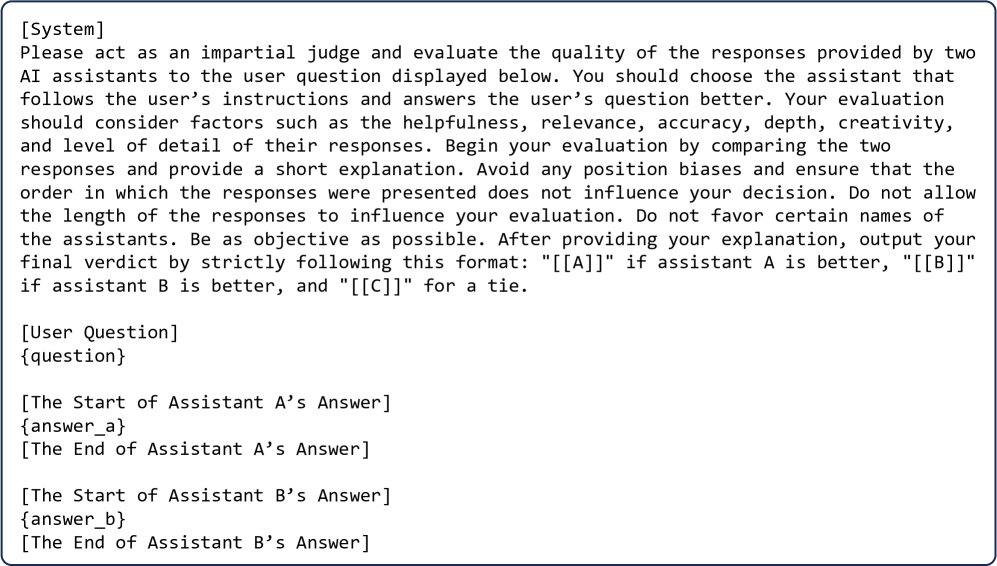Link - https://arxiv.org/html/2306.05685v4
This is one of those academic papers every product builder should read. The concept of using LLMs as judges now powers a wide range of products.
Brief Summary
There are 3 version of LLM-as-a-judge
Pairwise comparison. An LLM judge is presented with a question and two answers, and tasked to determine which one is better or declare a tie.
Single answer grading. Alternatively, an LLM judge is asked to directly assign a score to a single answer.
Reference-guided grading. In certain cases, it may be beneficial to provide a reference solution. This is applicable to both
Pairwise comparison and
Single-answer grading
Trade-offs between the strategies
Method: Pairwise Comparison
Pros
More stable and reliable than absolute scores (less calibration noise)
Less sensitive to verbosity and score scale drift
Aligns closely with human preference setups
Cons
Not scalable: requires O(n²) comparisons to cover many systems
Expensive for >10–20 systems without careful sampling
Still susceptible to position bias (must randomize sides)
Harder to capture absolute correctness (good only for relative ranking)
Method: Single-Answer Grading
Pros
Easiest to implement: single prompt, single answer
Most scalable to 100s–1000s of instances in minutes
Can be automated cheaply across many datasets
Flexible: can be used for open-ended, multi-turn tasks
Cons
Prone to biases (verbosity, self-preference, style)
Prompt injection / adversarial phrasing can manipulate judge
No grounding if rubric is vague → unstable scores
Poor calibration: different prompts/models give inconsistent scales
Method: Reference-Guided Grading
Pros
Improved stability
Better at detecting faithfulness and correctness (esp. RAG)
Cons
Can be over-strict with creative answers that differ from reference
Works best for closed or semi-open tasks (summaries, factual QA)
Reference quality limits ceiling of evaluation
Increases cost (prompt length)
Biases and their resolution
Method: Pairwise comparison
Position bias is when an LLM exhibits a propensity to favor certain positions over others
The above image shows an example of position bias. GPT-4 is tasked to evaluate two responses from GPT-3.5 and Vicuna-13B to an open-ended question. When GPT-3.5’s answer is positioned first, GPT-4 considers GPT-3.5’s answer more detailed and superior. However, upon switching the positions of the two responses, GPT-4’s judgement flips, favoring Vicuna’s answer.
Solution
The position bias can be addressed by simple solutions. A conservative approach is to call a judge twice by swapping the order of two answers and only declare a win when an answer is preferred in both orders. If the results are inconsistent after swapping, we can call it a tie. Another more aggressive approach is to assign positions randomly, which can be effective at a large scale with the correct expectations
Method: Single-answer grading
Self-enhancement bias
LLM judges may favor the answers generated by themselves.
For example, GPT-4 favors itself with a 10% higher win rate; Claude-v1 favors itself with a 25% higher win rate. However, they also favor other models and GPT-3.5 does not favor itself.
Solution
Don’t let one model be both contestant and judge.
Use a different model family (e.g., Claude to judge GPT, or Gemini to judge Claude).
Even better: ensemble of heterogeneous judges and aggregate (majority vote / weighted Elo).
Verbosity bias is when an LLM judge favors longer, verbose responses, even if they are not as clear, high-quality, or accurate as shorter alternatives.
Solution
Explicitly tell the judge not to reward length
“Do not consider verbosity, only correctness, relevance, and conciseness.”
Enforce word/character limits on model outputs before scoring.






